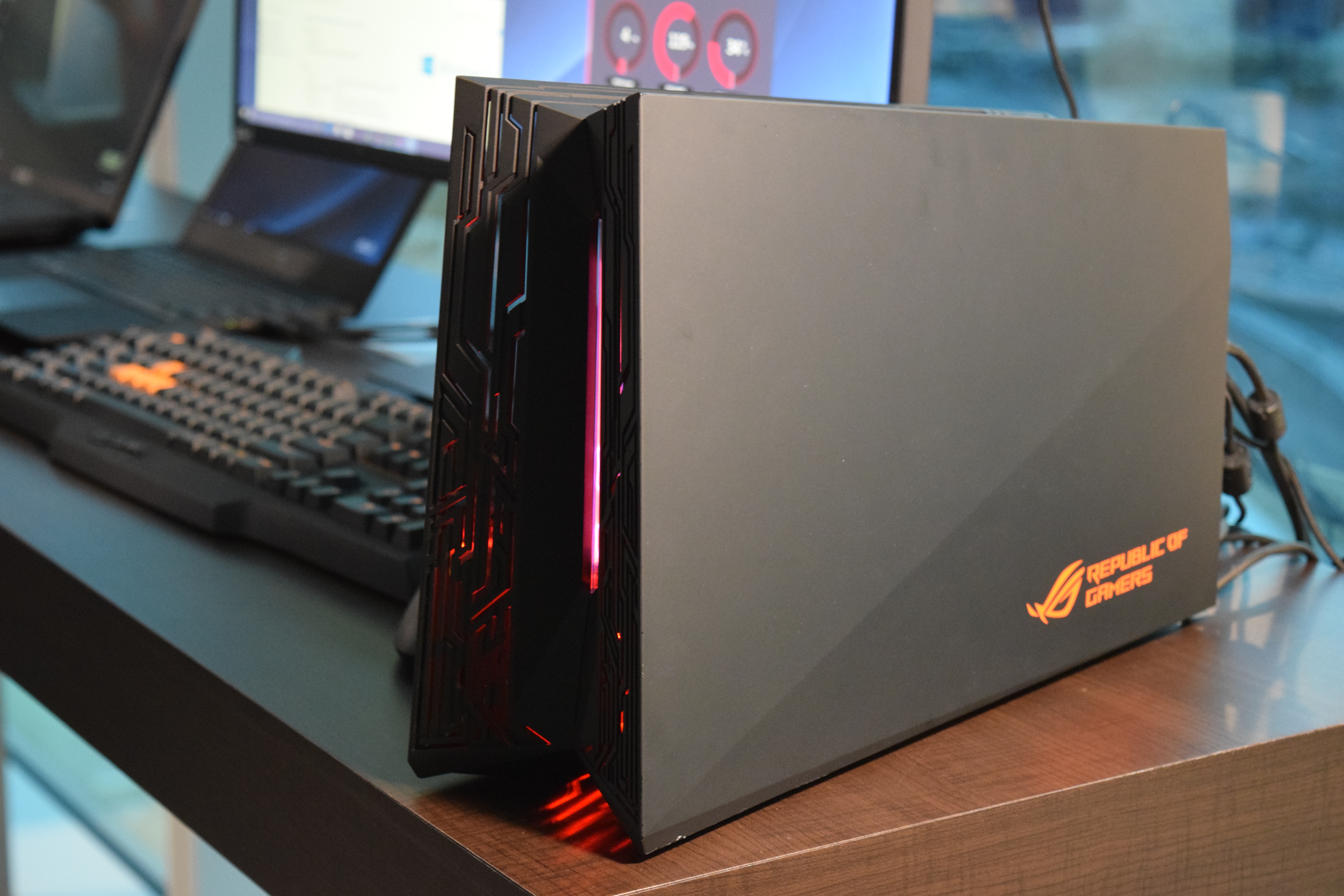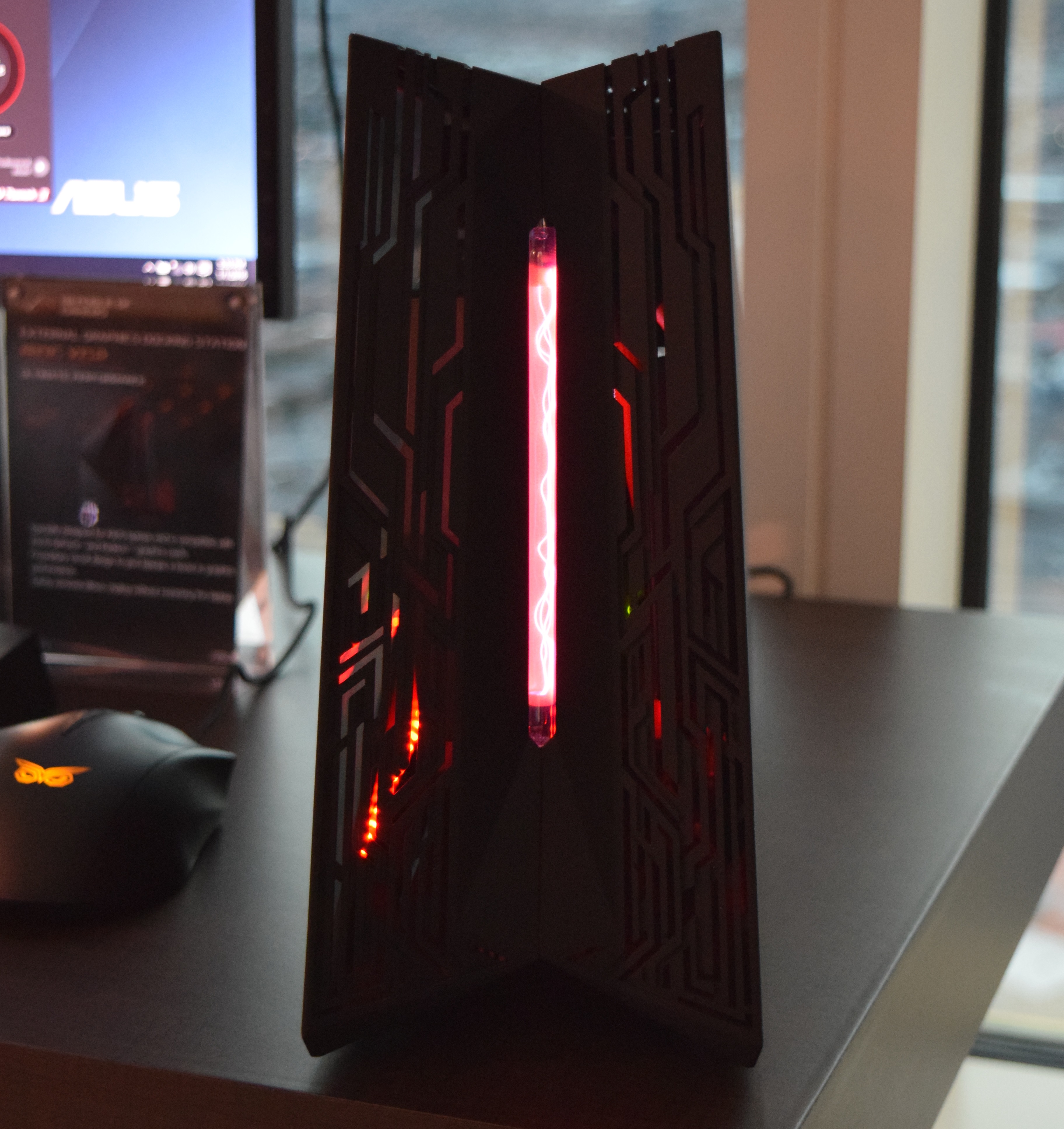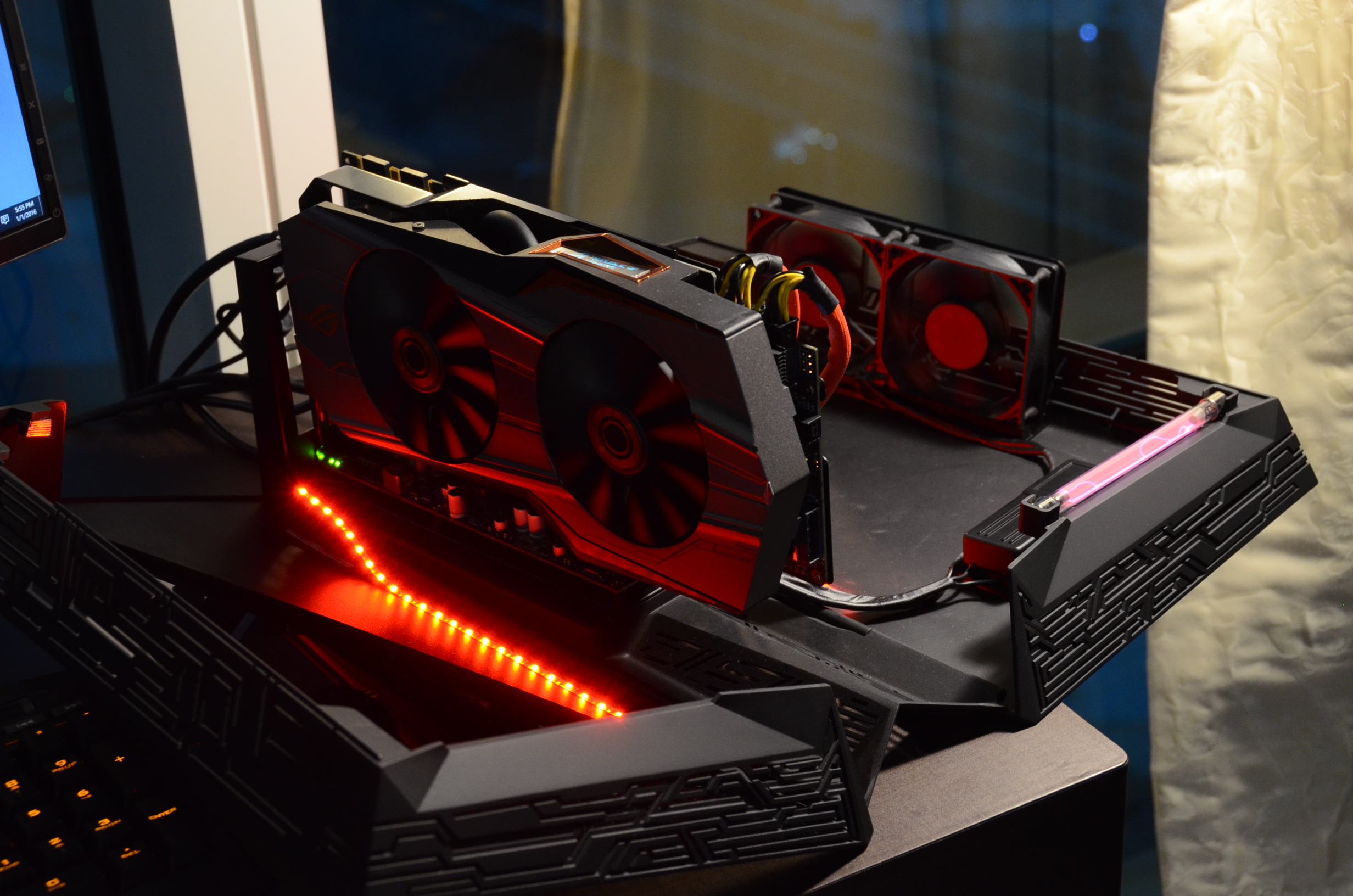Asus Debuts Graphics Dock That Uses PCIe Over USB-C
It seems like there are a slew of vendors releasing mobile desktop graphics docks at CES, but Asus appears to be differentiating from the typical solution with its ROG XG2 graphics dock. The dock is designed to work with particular Asus mobile devices (no word on which ones just yet) and unlike other competing devices, it uses PCI-e bandwidth instead of Thunderbolt.
We got to check out the Asus ROG XG2 at the company’s suite in Las Vegas, and it definitely catches the eye. A tinted side panel shows off the LED-lit interior, which can house virtually any graphics card on the market today. The side panel also has a small space between the chassis and glass to allow air intake.
Perhaps it’s just me, but the LED lighting and plasma tube on the front make for an impressive design, clearly more flashy than practical in some cases. The chassis itself is not as sturdy as the Razor Core, which used heavy steel for its case, and the XG2 is much lighter by comparison.
Another key difference, and possibly unique from any other graphics dock we’ve seen so far, is that the ROG XG2 uses two USB Type-C cables to connect to the mobile devices (in our case, an Asus ZenBook). This is because the XG2 uses PCI-e lanes to transfer the data between the dock and the PC.
Asus explained that Thunderbolt 3 interfaces can create latency for external graphics docks, so the company decided to implement the dual-USB Type-C configuration to use four PCIe-3.0 lanes instead. Each cable handles two PCI-e lanes, and the interface provides adequate bandwidth to run even the most powerful graphics cards (Asus explained that its internal testing with a Titan X showed that four lanes operate at 99.99% of the performance of a x16 lane interface). Additionally, the USB Type-C ports on the PC will automatically switch between USB protocols and PCI-e protocols based on what you plug into it.
There’s no word on price or availability yet, but more importantly, it opens like a taco.
Derek Forrest is an Associate Contributing Writer for Tom’s Hardware and Tom’s IT Pro. Follow Derek Forrest on Twitter. Follow us on Facebook, Google+, RSS, Twitter and YouTube.
Get Tom's Hardware's best news and in-depth reviews, straight to your inbox.
Derek Forrest was a contributing freelance writer for Tom's Hardware. He covered hardware news and reviews, focusing on gaming desktops and laptops.
-
kewlguy239 The cables we saw at the Asus suite were plenty long enough to make the dock a stationary fixture on a desk while being able to reach the PC. They were about 2-3 feet in length, so unless you are planning to place the dock on the floor and run the cables up to laptop, it should be sufficient.Reply -
cknobman I'd really love to see some benchmarks with a graphics card in one of these things compared to a similar platform with the card plugged right into the motherboard.Reply -
Xajel The problem with this approach is well, compatibility, as not all laptops will be equipped with such USB/PCIe hybrid ports...Reply
Razer solution I think it's better, Thunderbolt 3 is a standard after all, not all laptops have it, but most high-end have it, and even some mid-rangers too... the dock provides also 4x USB 3.0 ports and 1x Gigabit Ethernet port.. making it a very nice dock indeed as it will allow to use only one cable to have everything ready... -
falchard I feel bandwidth may be an issue here. Although USB 3 is fast. Its no where near as fast as PCI-e. We are starting to get to a point where Graphics cards are using up a PCI-e 2.0 x16 which is 6 times more bandwidth than USB 3.1.Reply -
abbadon_34 ReplyThe problem with this approach is well, compatibility, as not all laptops will be equipped with such USB/PCIe hybrid ports...
Razer solution I think it's better, Thunderbolt 3 is a standard after all, not all laptops have it, but most high-end have it, and even some mid-rangers too... the dock provides also 4x USB 3.0 ports and 1x Gigabit Ethernet port.. making it a very nice dock indeed as it will allow to use only one cable to have everything ready...
Thunderbolt has never seen widespread adoption, so this does seem to have a wider market. If nothing else, it is good have the choice, and a competing technology is good for everyone.
I feel bandwidth may be an issue here. Although USB 3 is fast. Its no where near as fast as PCI-e. We are starting to get to a point where Graphics cards are using up a PCI-e 2.0 x16 which is 6 times more bandwidth than USB 3.1.
True, which is why they are using two (2) cables. Which begs the question, how about using 3 or 4 cables? How about multiple Thunderbolt on a Razer-type system?
Asus explained that its internal testing with a Titan X showed that four lanes operate at 99.99% of the performance of a x16 lane interface
I would _love_ to see Tom's do an article/test like this.
-
Quixit ReplyThunderbolt has never seen widespread adoption, so this does seem to have a wider market. If nothing else, it is good have the choice, and a competing technology is good for everyone.
No it doesn't, did you even read the article? It's totally proprietary and only works with ASUS products that support their proprietary PCIe over USB scheme (which is effectively what thunderbolt 3 also is, it's just better than ASUS's version.
The purpose of ASUS's system is to lock out other vendors, real scummy considering a better, standardized solution is already available. You need 2 cables for the same 4 PCI-E 3.0 lanes you'd get with a Thunderbolt 3 system. It might save them a few bucks too, assuming that the hardware they're using costs less than Intel's Alpine Ridge Thunderbolt 3 controller, but it's a lot less flexible too seeing as you can't just plug in anything that supports Thunderbolt 3. -
Loganmac Hey, Im a massive noob when it comes to uhh computers and GPAs but a few years ago I got a Asus G750JW Notebook (http://www.notebookcheck.net/Review-Asus-G750JW-Notebook.96316.0.html) and lately the performance been lacking. Would this be a viable option for me? Like would it work?Reply


